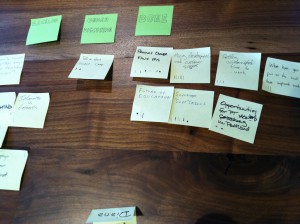LeanCoffee is off to a great start. We’ve moved to the amazing New Relic offices on the 28th floor downtown and the conversations have become as soaring as the view. Often New Relic employees showing up bleary eyed to work encounter a passionate discussion raging in their lunch room and wander near to see what’s got everyone so charged up before 8 in the morning.
LeanCoffee is great for sharing and learning. Its agenda-less nature lets the group determine the most interesting topic and spend the most time discussing them via democratic voting. Looking at a single topic from the last session, here’s what I leaned in just the first 10 minutes.
Fresh from ProductCamp this weekend, I was turning over the role of Product Owner in my head. At AgileOpen NW, I was surprised to hear knowing jabs at the role. In such an inclusive and supportive environment, it seemed out of place. Or perhaps I was just sensitive as that job is what I do for a living? Why are people so disappointed with their POs? I came across this attitude again while getting my Scrum Master certification. In the small class, the teacher was surprised to have a PO interested in taking it and over the course of the two days I heard many more snarky digs at the role. What gives?
So in an attempt to use the LeanCoffee format to tease out an answer, I suggested the topic “Product Owner faux pas”. It got the most votes and was the first topic of conversation. We ran through the first 6 minutes then two additional 2 minute sessions (10 minutes total). People were all too happy to share where they’ve seen POs fall down and I learned a lot.
After I briefly introduced the topic…
Diana suggested that while the role seemed like a good idea during the creation of Scrum, none of the architects had actually held the role.
I offered that the Scrum coach mentioned the PO is often not treated as part of the team.
And then around the table it went…
PO is the most reviled role in Scrum
POs often have many projects and aren’t available to the team as they should be
As engineers think ‘we just have to fix this PO’, ProductCamp showed that POs think they should fix engineers
Companies don’t make the PO role a priority
At what point does an ‘on-site customer’ lose their relevance
Upon mention of proactive backlog grooming and story estimation: Oh, I wish my PO would do that!
In just a few minutes I learned pain points from the perspective of teams and POs which can immediately help me be better in my job. That’s the beauty of LeanCoffee: lightning rounds and rapid idea exchange around highly interesting and relevant topics.
There was a lot more territory covered and in each an opportunity for learning and reflection. Some of my favorites:
New Relic’s customer service model of having their engineers rotate into a Support Hero role
Using the Pomodoro timer as a way to set expectations for office mates to allow for uninterrupted work flow
Creating a Rumor Control Board on the wall to allow for not only the validation and squashing of rumors, but also the frame that until validated by someone, a rumor is only a rumor.
Above all the session is infused with laughs and mutual support. It’s a great way to wake up: getting caffeinated with smart people and sharing unexpected ideas and war stories. I’ve always left richer than when I arrived.
Free Tickets for the next LeanCoffee are at Eventbrite


